
Rookwood Cemetery is a heritage-listed cemetery in Rookwood, Sydney, New South Wales, Australia. It is the largest necropolis in the Southern Hemisphere and is the world's largest remaining operating cemetery from the Victorian era. It is close to Lidcombe railway station about 17 kilometres (11 mi) west of the Sydney central business district. It was added to the New South Wales State Heritage Register on 2 April 1999.
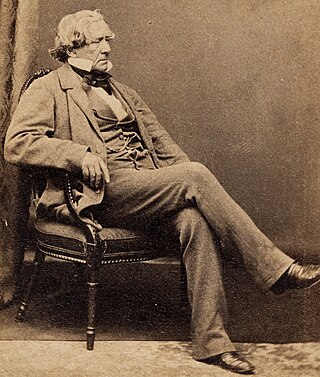
William Charles Wentworth was an Australian statesman, pastoralist, explorer, newspaper editor, lawyer, politician and author, who became one of the wealthiest and most powerful figures in colonial New South Wales. He was among the first colonists to articulate a nascent Australian identity.

Frogmore is an estate within the Home Park, adjoining Windsor Castle, in Berkshire, England. It comprises 33 acres (130,000 m2), of primarily private gardens managed by the Crown Estate. It is the location of Frogmore House, a royal retreat, and Frogmore Cottage. The name derives from the preponderance of frogs which have always lived in this low-lying and marshy area near the River Thames. This area is part of the local flood plain. Its large landscaped gardens are Grade I listed on the Register of Historic Parks and Gardens.
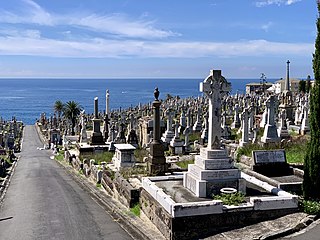
The Waverley Cemetery is a heritage-listed cemetery on top of the cliffs at Bronte in the eastern suburbs of Sydney, New South Wales, Australia. Opened in 1877 and built by R. Watkins and P. Beddie, the cemetery is noted for its largely intact Victorian and Edwardian monuments. It is regularly cited as being one of the most beautiful cemeteries in the world. The cemetery contains the graves of many significant Australians including the poet Henry Lawson. Also known as General Cemetery Waverley, it was added to the New South Wales State Heritage Register on 28 October 2016.
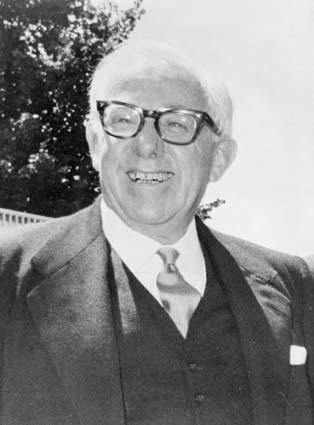
William Charles Wentworth, usually known as Bill Wentworth and sometimes referred to by others as William Charles Wentworth IV, was an Australian politician. He was a member of the Liberal Party for most of his career and held ministerial office in the governments of John Gorton and William McMahon, serving as Minister for Social Services (1968–1972) and Minister in charge of Aboriginal Affairs (1968–1971). Wentworth served in the House of Representatives from 1949 to 1977, representing the New South Wales seat of Mackellar. He frequently crossed the floor and served his final months in parliament as an independent.
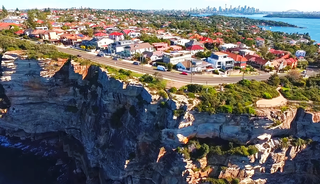
Vaucluse is an eastern suburb of Sydney, in the state of New South Wales, Australia. It is located 8 kilometres (5 mi) east of the Sydney central business district, in the local government areas of Waverley Council and the Municipality of Woollahra.

Wentworth is a village and civil parish in the Metropolitan Borough of Rotherham in South Yorkshire, England.

Vaucluse House is a heritage-listed residence, colonial farm and country estate and now tourist attraction, house museum and public park, formerly the home of statesman William Charles Wentworth and his family. It is located at 69a Wentworth Road, Vaucluse in the Municipality of Woollahra local government area of New South Wales, Australia. Completed between 1803 and 1839 in the Gothic Revival style, its design was attributed to W. C. Wentworth and built by Sir Henry Browne Hayes and W. C. Wentworth. The property is owned by the Historic Houses Trust of New South Wales, an agency of the Government of New South Wales. The site was added to the New South Wales State Heritage Register on 2 April 1999.

Newington House is a historic house in Silverwater, New South Wales, Australia and is located 20 kilometres (12 mi) west of the Sydney central business district, in the local government area of the City of Parramatta. The house and chapel are situated on the southern bank of the Parramatta River and are now enclosed by the Silverwater Correctional Centre. With Elizabeth Bay House and Camden Park, it is considered to be one of the three great houses of the County of Cumberland.

Oakwood Cemetery is a nonsectarian rural cemetery in northeastern Troy, New York, United States. It operates under the direction of the Troy Cemetery Association, a non-profit board of directors that deals strictly with the operation of the cemetery. It was established in 1848 in response to the growing rural cemetery movement in New England and went into service in 1850. The cemetery was designed by architect John C. Sidney and underwent its greatest development in the late 19th century under superintendent John Boetcher, who incorporated rare foliage and a clear landscape design strategy. Oakwood was the fourth rural cemetery opened in New York and its governing body was the first rural cemetery association created in the state.

Mortimer William Lewis was an English-born architect, surveyor and public servant who migrated to Australia and became Colonial Architect in the colony of New South Wales from 1835 to 1849. Lewis was responsible for designing and overseeing many government buildings in Sydney and rural New South Wales, many of which are heritage listed.
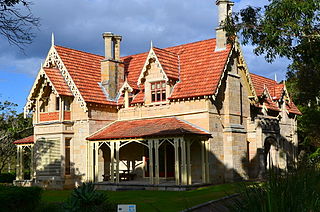
Greycliffe House is an historic, two-storey residential dwelling situated in the Sydney suburb of Vaucluse, New South Wales, Australia. Completed in c. 1852 in the Victorian Rustic Gothic style, Greycliffe is listed on the Australian Register of the National Estate and on the Municipality of Woollahra local government heritage list.

Rona is a historic house in the Sydney suburb of Bellevue Hill, New South Wales, Australia. The house is listed on the Australian Register of the National Estate and is listed on the Municipality of Woollahra local government heritage list. The house is situated in the northern end of the suburb and sold for A$58 million in 2018, making it one of Australia's most expensive homes at the time.

Nielsen Park is a heritage-listed historic site, park and nature reserve located at Greycliffe Avenue, Vaucluse in the Municipality of Woollahra local government area of New South Wales, Australia. The traditional lands of the Birrabirragal indigenous people, the park was designed by John Frederick Hilly, James Barnet and the Office of the New South Wales Government Architect. It is also known as Vaucluse Estate, Greycliffe Estate and Greycliffe House. It was added to the New South Wales State Heritage Register on 28 August 2017.

The South Head General Cemetery is a heritage-listed cemetery located at 793 Old South Head Road, Vaucluse, New South Wales, Australia. It was built from 1845 to 1950. It is also known as Old South Head Cemetery and the South Head Cemetery. The property is Crown Land governed by Waverley Municipal Council. It was added to the New South Wales State Heritage Register on 25 August 2017.

Wentworth Memorial Church is a heritage-listed former Anglican church building located at 32B Fitzwilliam Road, Vaucluse, Sydney, Australia. It was designed by Clarke Gazzard and Partners and built by Monteith Constructions, with Miller Milston and Ferris as engineers. The property is privately owned; and was formerly owned by the Anglican Diocese of Sydney. It was added to the New South Wales State Heritage Register on 25 September 2012.

St Johns Anglican Church Precinct, also known as St John's Camden, is a heritage-listed Anglican church and associated precinct at 6-22 Menangle Road, Camden, Camden Council, New South Wales, Australia. The precinct comprises the church, rectory, cemetery, two church halls and grounds that provide a rural landscaped environment to the group. The dominant feature of the precinct is the historic St John's the Evangelist Anglican Church. Its architects are unknown, and could be the cumulative work of Mortimer Lewis, John Cunningham and Edmund Blacket. It was built from 1840 to 1849 with Richard Basden responsible for the nave and John Le Fevre adding the spire. 1874 saw the addition of the chancel and vestry, their builder is unknown and the design is likely the work of Sir George Gilbert Scott and Blacket. A feature of the church is an organ manufactured by J. Bates & Son, London. The Anglican Church Property Trust of the Diocese of Sydney holds the property in trust, under the Anglican Church of Australia Trust Property Act 1917 (NSW). The precinct was added to the New South Wales State Heritage Register on 24 August 2018.

The Royal Mausoleum is a mausoleum for Queen Victoria and her husband Prince Albert, Prince Consort. It is located on the Frogmore estate within the Home Park at Windsor in Berkshire, England. It was listed Grade I on the National Heritage List for England in October 1975. Built between 1862 and 1871, Albert, who died in 1861, was interred in the mausoleum in 1871 following its completion. Victoria was interred on 4 February 1901 following her death in late January.
John Frederick Hilly was a surveyor and architect who designed commercial buildings, churches and houses in mid-nineteenth-century Sydney, New South Wales. He was born in Warwickshire and arrived in Australia in 1839. On 8 January 1842 Hilly married Ellen Morgan at Christ Church St Laurence in Sydney. Hilly Street in Mortlake, New South Wales, is named in his honour. Works attributed to Hilly include:

Sarah Wentworth was an Australian currency lass and apprentice. She brought the first breach of promise suit in Australia, during which she was represented by barrister and statesman William Wentworth, her future husband.





















